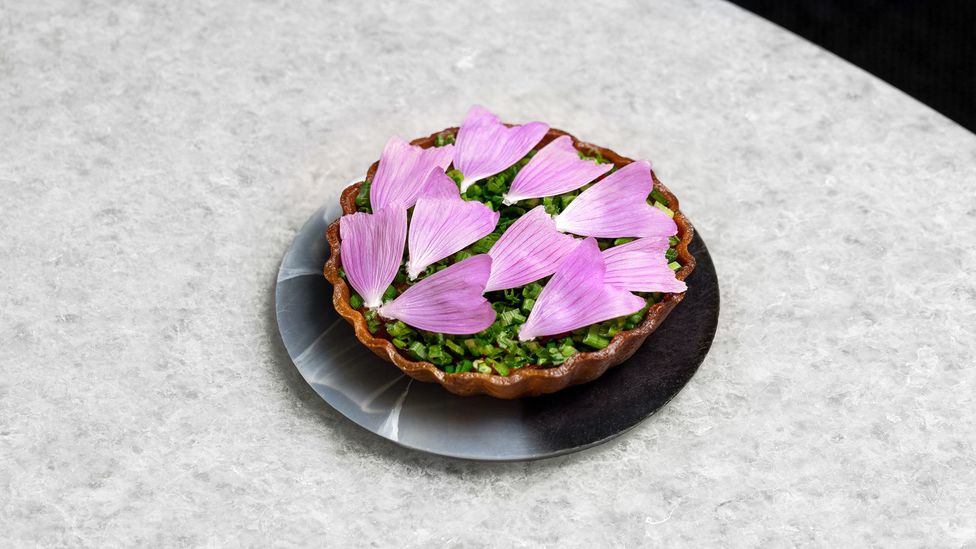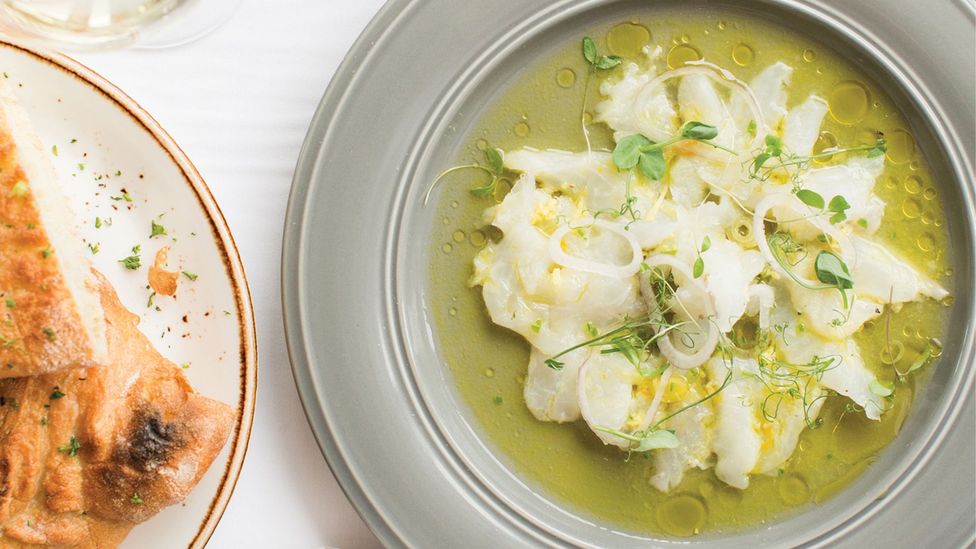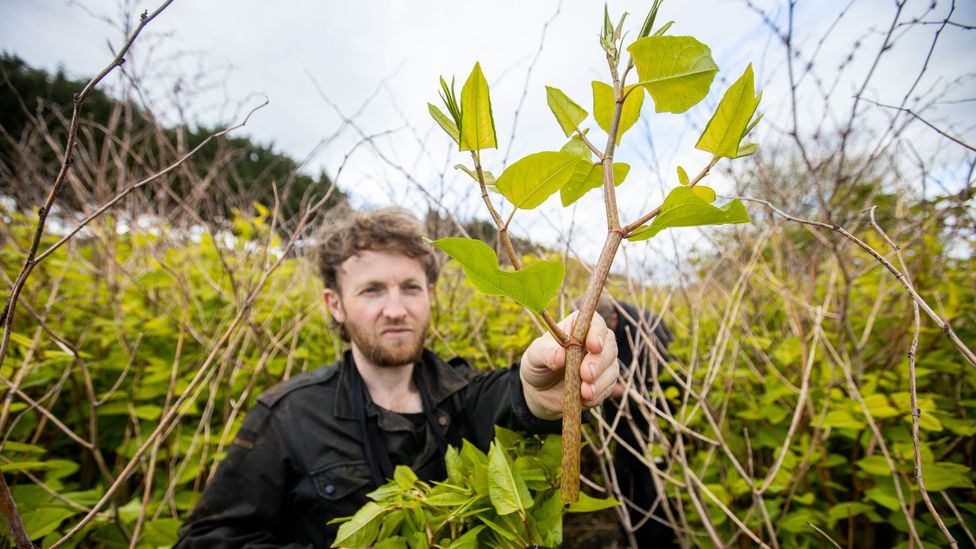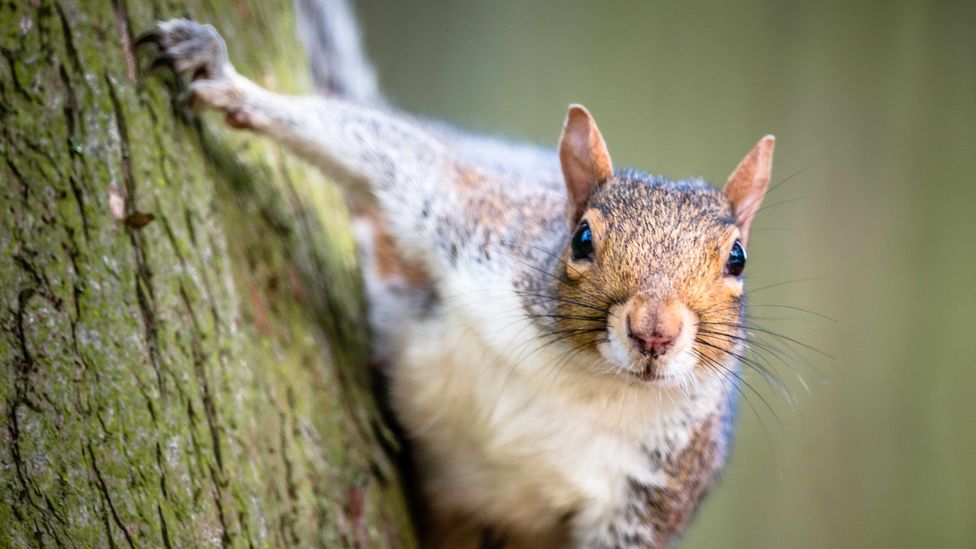The beer I'm sipping has a sharp, tart flavour, similar to rhubarb. But fruit isn't the main ingredient. The cold brew is made from the UK's most damaging plant: Japanese knotweed.
Introduced in the UK as a highly prized ornamental plant in the mid-19th Century, Japanese knotweed is widely considered one of the world's most intractable invasive species. With its creeping roots, the weed can smother gardens and parks and is the scourge of homeowners.
But at Silo, the zero-waste restaurant in east London where I'm dining, Japanese knotweed is a firm favourite. Head chef Doug McMaster has been cooking with the weed for years. "It's an amazing ingredient," he says. "It's incredibly versatile; it can be grilled, it can be cooked, it can be turned into beer, fermented and pickled. (Read more about the alien shrub that can't be stopped).
"When you cook it, it tastes like rhubarb. When it's raw, it's more like asparagus, with a slightly sour flavour," he says.

Doug McMaster, head chef at Silo, a zero-waste restaurant in London, has been cooking with invasive species for more than 10 years (Credit: hdg_photography)
McMaster sees cooking with invasives as a solution that can help raise awareness of the environmental harm caused by these species.
At his invasive species supper club, McMaster plates up an astonishing selection of pests including grey squirrel kofta, fallow deer parfait, crayfish tartlet and Pacific oysters.
Invasive species introduced to ecosystems are costing the global economy more than $423bn (£333bn) every year, by harming nature, human health and food security, according to a report by the Intergovernmental Science-Policy Platform on Biodiversity and Ecosystem Services. The costs have at least quadrupled every decade since 1917. Between 1970 and 2017, the world lost $1.3tn (£1.02tn) to invasives.
Sign up to Future Earth
Sign up to the Future Earth newsletter to get essential climate news and hopeful developments in your inbox every Tuesday from Carl Nasman. This email is currently available to non-UK readers. In the UK? Sign up for newsletters here.
The introduction of invasive species has led to 25% of plant extinctions and 33% of animal extinctions since 1500, according to a 2019 study. Across the US, there are more than 6,500 invasive species, many of which are wreaking havoc on native ecosystems and wildlife. Climate change is increasing the spread of invasives, as warmer temperatures allow pests to expand their range to new habitats which were previously too cool.
Can we beat these pests by eating them? This idea, coined "invasivorism", was developed by conservation biologist Joe Roman 20 years ago.
Sustainability is about balance. Invasive species are pushing that balance out of whack – Doug McMaster
"I have spent my career as a conservation biologist trying to convince people not to overharvest things," says Roman, who is associate professor at the Rubenstein School of Environment and Natural Resources at the University of Vermont. "It suddenly occurred to me that we could flip the script and find a way to consume animals and plants where it is actually beneficial for the environment."

Crayfish tartlet is just one of the invasive species dishes on Silo's menu (Credit: hdg_photography)
Roman started foraging for green crabs and periwinkles, an invasive sea snail native to Europe, and found that "they're pretty easy to cook…you just sauté them and they're delicious!"
But the idea didn't catch on immediately. "People just thought it was kind of a quirky idea," says Roman. But 10 years ago, invasivorism really "took off" as restaurants and chefs started focusing more on local ingredients and sustainability, he says.
"Invasive species are a negative force on the environment," says McMaster. "Sustainability is about balance. Invasive species are pushing that balance out of whack."
He believes that eating invasives helps restore balance to ravaged ecosystems and educates people about how these pests are decimating local wildlife.
Environmental education lies at the heart of invasivorism, Roman agrees. "People don't know which species are native and which ones are invasive. It's about getting people outside, foraging and learning about their local ecosystem."
Chefs cooking with invasives are helping people get over "the disgust factor" of trying strange new ingredients, says Roman. "If you go to a restaurant and a chef serves you [an invasive species], then you're likely to be much more open minded about it."
Brody Olive, executive chef at the Perdido Beach Resort in Orange Beach, Alabama, has been cooking with invasives for more than 10 years. He started cooking with lionfish, a highly destructive invasive species with a row of venomous spines on their backs and a voracious appetite. (Watch: The hungry lionfish devouring Florida's coast.)

Chef Brody Olive makes a Peruvian-style lionfish ceviche dish, sprinkled with coriander, fresh ginger and satsuma juice (Credit: Perdido Beach Resort)
Lionfish are native to the Indo-Pacific region, but started infiltrating Atlantic coastal waters in the 1980s. Without natural predators to keep them in check, lionfish pose a serious threat to marine ecosystems beyond their natural range, consuming over 50 species of fish.
The firm, white fish tastes similar to grouper and mahi mahi, or dorado. Olive makes a Peruvian-style lionfish ceviche dish, sprinkled with coriander, fresh ginger and satsuma juice. He also roasts lionfish whole in the oven. "Lionfish are really delicious and hold up to many different cooking applications," he says.
Olive sources lionfish from local divers and spearfishing tournaments. He warns that people should not prepare lionfish at home as the fish has venomous spines which can cause injury.
Cooking with prolific pests such as lionfish won't necessarily help eradicate them, however. "We barely put a dent in populations," he says, adding that his main goal is to help educate people about the dangers of invasives and to feel "really connected with our local food and our environment".
"It's a great talking point with our guests," he says. "Hopefully they go out and help spread the message."
You might also like:
- Why US ranchers are becoming beaver believers
- The paradox of the 'gentle protest'
- Why it's so hard to eat local food on a budget
Can you cook with other invasives at home? Periwinkles, green crab and feral hog are all safe and easy to prepare in your own kitchen, say Roman and Olive. The difficulty is sourcing these invasives in the first place as there aren't proper supply chains.
"Sourcing invasives is a real labour of love," says McMaster who works closely with local foragers. "I don't encourage people to source invasives themselves unless they are foragers," he says. People not only run the risk of injury, they could also spread the pest further afield, McMaster says, adding that he is always "triple cautious" when handling Japanese knotweed.
Japanese knotweed can regrow from a single root fragment, weighing just 0.5g (0.02oz), slightly bigger than a pinch of salt.
"We burn all the excess scraps," says McMaster. "We're not taking any risks."
"You should never move living invasives around," says Roman. "The worst-case scenario would be introducing the species somewhere else."

Doug McMaster turns Japanese knotweed, one of the world's most intractable invasives, into beer (Credit: Victor Frankowski)
The dessert on Silo's invasive species menu is ice cream topped with a granita made from Himalayan balsam, a plant with vibrant pink flowers which is native to the Himalayas and invasive in many parts of Europe. This plant makes a beautiful garnish for a cocktail, salad or dessert and has a "mind blowing" bubblegum-like flavour, says McMaster.
But Himalayan balsam's pretty appearance masks a destructive power. The weed guzzles up enormous amounts of water, and leaves river banks bare and at risk of erosion. The plant can grow 2m (6.6ft) in one season in the UK and produce up to 800 seeds. When ripe, the pods explode and shoot seeds up to 7m (22ft) away.
By including Himalayan balsam on his menu, McMaster hopes to highlight how sensitive this weed is to local fauna, so that people think twice before letting their dogs off in a patch of pink flowers, resulting in "a firework display of seeds".
McMaster expects invasive recipes to remain a "niche thing". "I'm not holding my breath that it will be in supermarkets any time soon," he says.
Roman says it is important invasive species don't become so popular that people start farming them, leading to larger populations.
He notes it's important to be clear that when promoting eating invasive species, that eradicating them from habitats where they are non-native is the goal. "[Local] extinction is the happy ending here."
--
If you liked this story, sign up for The Essential List newsletter – a handpicked selection of features, videos and can't-miss news delivered to your inbox every Friday.
Join one million Future fans by liking us on Facebook, or follow us on Twitter or Instagram.
